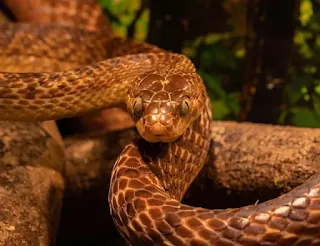The Deadly snakes
Snakes, belonging to the suborder have captivated human fascination and fear for millennia. Found on every continent except Antarctica, these limbless reptiles exhibit a wide range of adaptations and behaviors that make them one of the most diverse and successful groups in the animal kingdom. This essay delves into the evolutionary history, diversity, anatomy, behavior, ecological roles, cultural significance, and conservation challenges of snakes.
Snakes are thought to have evolved from terrestrial lizards over 100 million years ago, during the Cretaceous period. Fossil evidence suggests that early snakes retained hind limbs, which gradually disappeared as their bodies adapted for a burrowing lifestyle. The transition snakes to exploit narrow spaces and hunt more effectively, contributing to their evolutionary success.
The diversity of snakes today reflects their adaptive radiation into various ecological niches. From arboreal specialists like tree pythons to burrowing experts such as sand boas, snakes have evolved specialized anatomical features and behaviors suited to their habitats and prey preferences.
Snakes possess a streamlined body covered in scales, which aid in movement and protection. Their lack of limbs is compensated by powerful muscles that generate the undulating motion used for locomotion. Some snakes, like pythons and boas, have vestigial pelvic spurs, remnants of hind limbs from their evolutionary past.
Snakes are carnivorous, with highly specialized jaws and teeth adapted to their diet. Non-venomous snakes typically have numerous small teeth for grasping and holding prey, while venomous species have modified teeth (fangs) connected to venom glands. Venom serves to immobilize or kill prey, aiding in digestion and defense against predators.
Their sensory adaptations include a forked tongue used for chemoreception, allowing them to detect scent particles in the environment. Heat-sensitive pits, found in pit vipers and some pythons, enable infrared detection of warm-blooded prey, enhancing their hunting abilities in low-light conditions.
With over 3,000 species recognized today, snakes inhabit a wide range of ecosystems, from tropical rainforests to arid deserts and even underwater environments. Their adaptations are remarkable: arboreal snakes like the green tree python have prehensile tails and a strong grip, while aquatic species such as sea snakes possess flattened tails for efficient swimming.
The world's longest snake, the reticulated python can exceed 7 meters (23 feet) in length, while the smallest, the thread snake, measures just over 10 centimeters (4 inches). These size extremes reflect the diverse strategies snakes employ for survival and reproduction in their respective habitats.
Snakes exhibit diverse behaviors shaped by their ecological roles and life histories. Many are solitary hunters, relying on ambush or pursuit tactics to capture prey. Constriction is a common method used by boas and pythons to subdue larger animals, while venomous snakes strike swiftly to inject venom and incapacitate prey.
Reproduction in snakes varies widely. Most lay eggs (oviparous), which are typically deposited in concealed locations to protect them from predators and environmental extremes. Some species, including boas and pythons, give birth to live young (viviparous), nourished internally through a placental connection akin to mammals. A few snakes, such as the garter snake, exhibit ovoviviparity, where eggs hatch inside the female's body before birth.
As apex predators, snakes play crucial roles in maintaining ecological balance. They regulate prey populations, which in turn affects plant communities and the distribution of other animal species. Snakes are both predator and prey in food webs, serving as important links between lower and higher trophic levels.
Certain snake species are keystone predators, influencing entire ecosystems through their hunting behaviors. For example, the absence of rattlesnakes in certain habitats can lead to an increase in rodent populations, impacting vegetation and the diversity of other small mammals and birds.
Throughout human history, snakes have held symbolic and mythological significance in diverse cultures worldwide. In ancient Egypt, the cobra symbolized protection and royalty, depicted prominently in hieroglyphs and artifacts. Hindu mythology features the snake deity revered as guardians of water and fertility.
In Western cultures, snakes often symbolize both danger and wisdom. The biblical story of the Garden of Eden portrays the serpent as a tempter, leading to humanity's expulsion from paradise. Conversely, the caduceus—a symbol of medicine and healing—depicts a rod entwined by two serpents, reflecting snakes' association with renewal and transformation.
Despite their ecological importance and cultural relevance, snakes face numerous conservation challenges. Habitat loss and fragmentation threaten many species, particularly those with specialized habitat requirements. Illegal wildlife trade, driven by demand for exotic pets and traditional medicines, poses additional risks to snake populations globally.
Negative perceptions and fear of snakes contribute to their persecution and indiscriminate killing, often driven by misconceptions about their danger to humans. Conservation efforts focus on habitat preservation, education about snake ecology and behavior, and combating illegal trade through enforcement of wildlife protection laws.
Snakes are remarkable creatures that have adapted and thrived in diverse habitats across the globe. Their evolutionary history, anatomical adaptations, behavioral diversity, ecological roles, cultural significance, and conservation challenges underscore their importance in both natural ecosystems and human societies.








Post a Comment